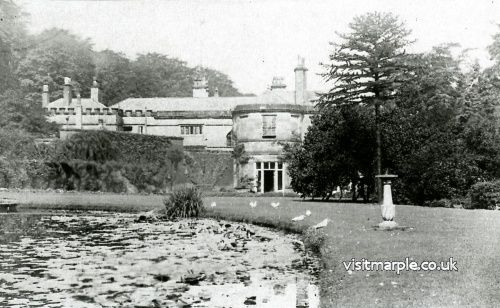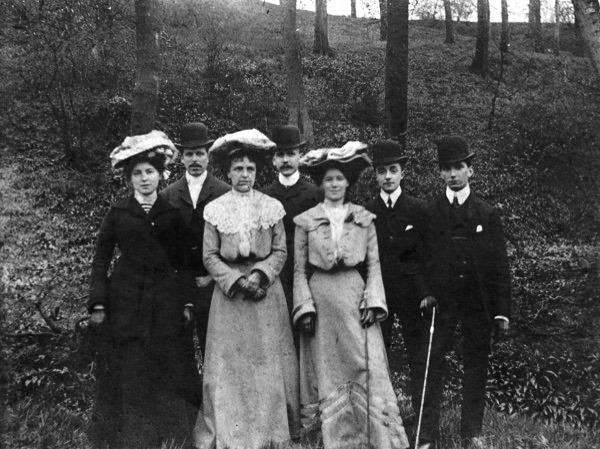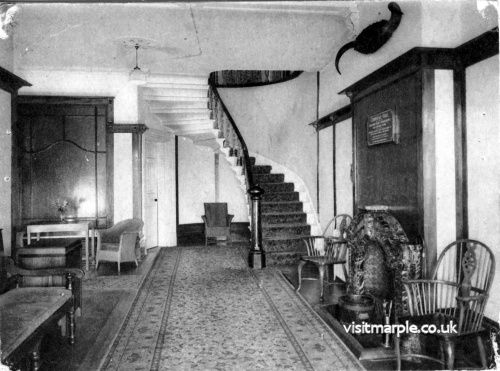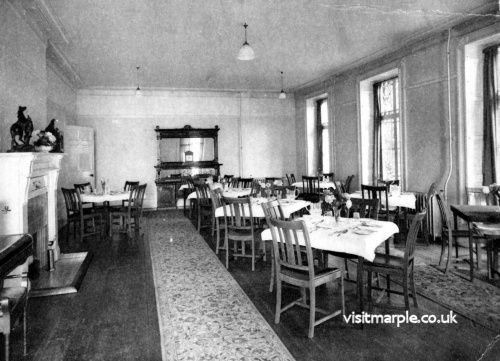From Wrexham I came by train to Chester, to Crewe, then another train to Stockport, then another train from Stockport to Marple. I was 16 years of age when I first came to Marple. An old school friend of mine who lived in Wales had a job of parlour maid at Brabyns Hall and I met her in Wrexham when she came home on holiday. We had been to school together with her five sisters. In the course of conversation she told me Miss Fanny Hudson who owned the Hall wanted a kitchen maid. She spoke for me and wrote a letter that I could have the job if I still wanted it.
 Brabyns Hall
Brabyns Hall
On Arriving, 26th July, 1926, the day was a beautiful sunny day, no one met me, so I asked someone where Brabyns Hall was and I was instructed to go down the cobbled road down the hill. Going down the hill was this very high wall and at the bottom were small cottages – which are still there. With my case and luggage I went up this driveway, taking the left turning past the coachman’s house and stables. On the right hand side was the farm, over the stables was a large clock, along the end of the driveway was this long tunnel which I went through and on the right hand side was a flight of approximately 10 steps. I knocked on the knocker. The door was opened by the butler who was expecting me and I asked for Janet, my friend.

Marple Hall Servants : pre-World War I
I was shown into the hallway of the servants quarters. I noticed the flooring was stone flags. There was a big wooden table with chairs for the housekeeper and butler, one at each end of the table, a bench and chairs for the rest of us; everyone had their own place at the table and mine and Janet’s were under the window on the bench. The cook-housekeeper came for me and took me to see Miss Hudson – she was in the morning room, she was an old lady, to me, very smart, tall, elegant with white hair swept upwards off her face with little curls on her forehead. She wore a long skirt and blouse, she was sitting on a chair, and she enquired if I’d had a pleasant journey and was concerned about my having a meal. I told her I hadn’t eaten since leaving home so she sent for my friend, Janet, to take me to the kitchen.
The cook-housekeeper showed me the kitchen which looked enormous to me. The fireplace was massive, a big black range with large ovens, two I remember, a large range with chains and other things hanging from it. The mantelpiece above it was very big, copper stew pans all along it and shelves with brassware on it. From the kitchen there was a passageway on the left, again all stone flooring and stone slabs with shallow stone sinks with one cold tap: the water was heated by boilers.
 Brabyns Hall InteriorMiss Hudson then spoke to me of my duties and that my wages would be 27/6d per month, uniform provided, blue cotton dress and a white cap and apron, black shoes and stockings. My hours were 7.15a.m. until 8.00p.m. and in between we had short breaks when we could sometimes go into the village to do some shopping or for a walk. Holidays were 2 weeks a year, no Bank Holidays or five-day week!
Brabyns Hall InteriorMiss Hudson then spoke to me of my duties and that my wages would be 27/6d per month, uniform provided, blue cotton dress and a white cap and apron, black shoes and stockings. My hours were 7.15a.m. until 8.00p.m. and in between we had short breaks when we could sometimes go into the village to do some shopping or for a walk. Holidays were 2 weeks a year, no Bank Holidays or five-day week!
On Bank Holidays, Miss Hudson would not let any of the young staff out at all. Local boys and girls walked the ‘monkey run’ which was Brabyns Hill.
Miss Hudson would sometimes let us go to the Carver, with the other staff, the cook being the chaperone and we weren’t allowed out of the grounds without a hat. Janet and myself had a little room in the attic. It had two beds in it, jug and basin for washing. We had a bath once a week, in the servants’ bathroom. The meals were wholesome, everything made in the kitchen and I was never hungry.
My duties were many and varied. My first job was brewing tea for the staff – a butler, Wilson (we never addressed the servants by ‘Mister’) – Phillips was the footman – a man in his 20’s and then there was the lady’s maid. I can’t recall her name – and another maid who was French, the head housemaid. Janet, my friend, was the under housemaid. Cook and I would then prepare breakfast, for the household. Dr Edward Hudson, nephew of Miss Fanny Hudson and many visitors who stayed with us – from Scotland, Marple Hall, Lyme Hall and also visitors from abroad.
 Brabyns Hall interior (during the First World War - soldiers rest home)All 11 of us had to be in the dining room by 8.45a.m. for morning prayers. Miss Hudson took the prayers – all of us standing. Then washing-up, preparing the vegetables, fetching and carrying for the cook. The cook was Mrs Wilson, wife of the butler. They had a daughter, Sarah, who worked at the Post Office in Marple Bridge. Mrs Wilson would teach me how to cook. I enjoyed it very much, we had plenty of game birds. I didn’t clean them, I think it was Phillips who did that job. On a Friday the cook, Phillips and I went to Stockport Market, in the trap with one little pony. Phillips also drove the car for the family and he had the coachman’s house near the stables. I remember him getting married and brought his wife back with him, we put holly in his bed and pebbles. They didn’t stay long after that. They went away to better himself, his wife being pregnant.
Brabyns Hall interior (during the First World War - soldiers rest home)All 11 of us had to be in the dining room by 8.45a.m. for morning prayers. Miss Hudson took the prayers – all of us standing. Then washing-up, preparing the vegetables, fetching and carrying for the cook. The cook was Mrs Wilson, wife of the butler. They had a daughter, Sarah, who worked at the Post Office in Marple Bridge. Mrs Wilson would teach me how to cook. I enjoyed it very much, we had plenty of game birds. I didn’t clean them, I think it was Phillips who did that job. On a Friday the cook, Phillips and I went to Stockport Market, in the trap with one little pony. Phillips also drove the car for the family and he had the coachman’s house near the stables. I remember him getting married and brought his wife back with him, we put holly in his bed and pebbles. They didn’t stay long after that. They went away to better himself, his wife being pregnant.
Sunday was morning service at St Martin’s. Men sat on one side of the church and women on the other. Mrs Shipley, wife of the vicar gathered together a group of young girls and formed 1st Marple Girl Guides. Janet and I joined. Miss Hudson let us go down to these evenings which was held in the school room behind the church. We spent many happy hours there.
Mr Hall was the lodge-keeper while I worked there. Mr Jones was the gardener. It was a very big garden, large greenhouses with grape and other fruits and he brought the vegetables and fruit daily to the kitchen.
From the attic window we could see the pond and the gardens, the dog cemetery and two beautiful peacocks that strutted along the wall. Miss Hudson was extremely fond of animals.
The dining room was on the front of the house. It was a large room with beautiful silver. The table was always laid properly. The butler and footman were responsible for it. The library was next to the dining room, plenty of books, a desk and chairs and some music in the corner. Evening meals were 5-course meals, usually lasting until 8.00p.m. The morning room looked out on to the pond and gardens. It was lovely in the summer and the house in winter was kept warm by log fires and coal. The head and under housemaid took care of this.
After 4 o’clock we had to change into a black dress, with clean cap and apron. All my memories of my two years there were very happy. I wanted to better myself so I went to Miss Eskridge on Bowden Lane and stayed with her eight years as cook-housekeeper until my own marriage.
I once went down the cellar with Janet, we had a candle, we were looking for the tunnel which went to Marple Hall. I only went so far.
Betty Johnson
Further Reading:
- January Meeting 2023: 'Brabyns Park & Iron Bridge' - Judith Wilshaw
- MLHS publication - Brabyns Hall and Park / e-Book / paper

